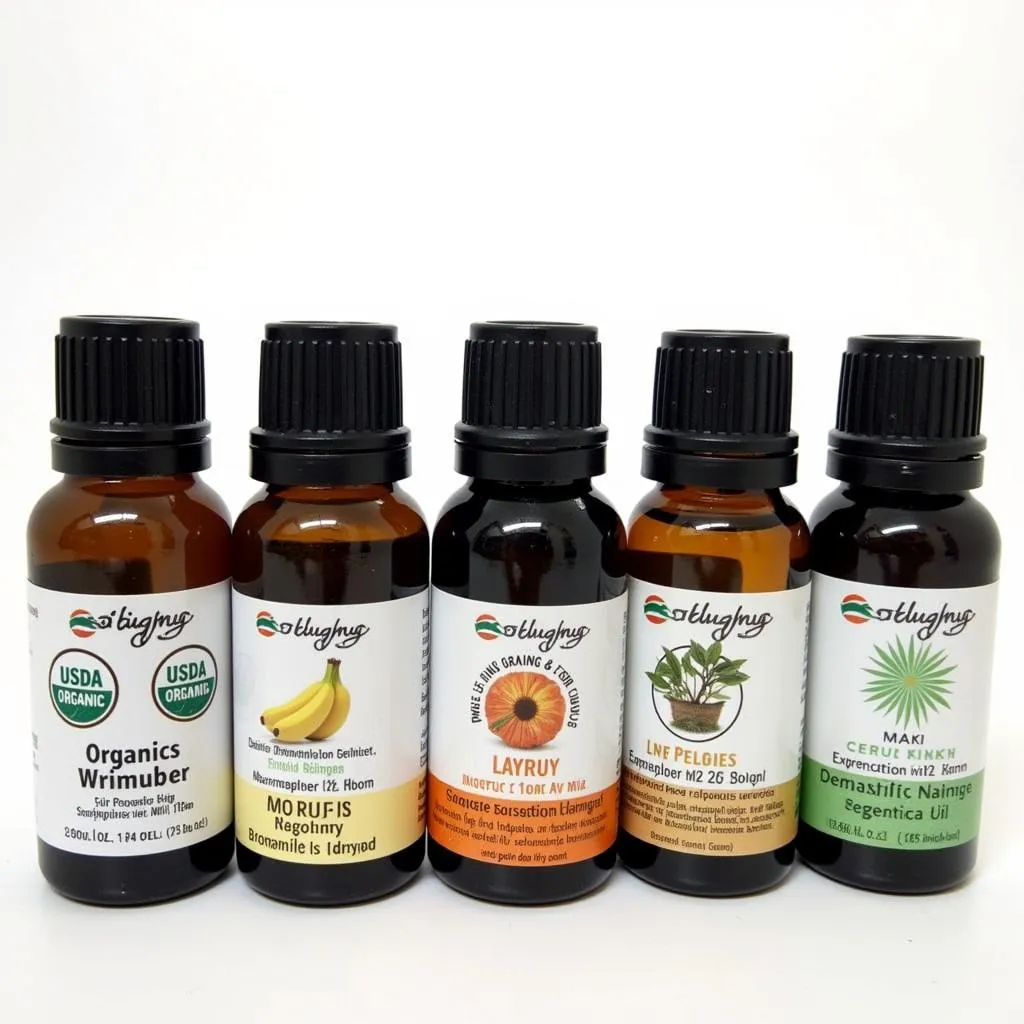Essential oils are popular for their aromas and therapeutic benefits, but did you know that some are also food grade and can add unique and delicious flavors to your dishes? Using food grade essential oils in cooking can elevate your culinary creations, adding a depth of flavor that traditional spices sometimes lack. However, not all essential oils are created equal, and using the wrong kind can be harmful.
This comprehensive guide explores the world of food grade essential oils, providing you with the knowledge to make informed choices for a safe and flavorful culinary experience. We’ll delve into reputable brands, safety tips, and creative ways to incorporate these potent flavor enhancers into your cooking.
What are Food Grade Essential Oils?
Food grade essential oils are highly concentrated plant extracts obtained through steam distillation or cold pressing. These oils are specifically processed to meet strict safety standards for consumption. They are labeled as “food grade” or “generally recognized as safe (GRAS)” by regulatory bodies like the FDA.
It’s important to note that essential oils are far more potent than dried herbs and spices. A little goes a long way, and using too much can lead to an overpowering flavor or even adverse reactions. Always start with a tiny amount and gradually increase as needed.
Choosing the Right Food Grade Essential Oils Brands
Selecting reputable brands is crucial when it comes to food grade essential oils. Look for brands that prioritize:
- Organic Farming: Ensure the oils are extracted from plants grown without harmful pesticides or herbicides.
- Purity and Quality: Choose oils that are 100% pure and have undergone rigorous testing for quality and authenticity.
- Clear Labeling: Look for labels that clearly state “food grade” and provide information on sourcing and extraction methods.
 Reputable food grade essential oil brands often display certifications and detailed information on their packaging.
Reputable food grade essential oil brands often display certifications and detailed information on their packaging.
Some well-regarded Food Grade Essential Oils Brands include:
- Plant Therapy: Known for its commitment to purity and transparency, offering a wide range of organic options.
- dōTERRA: A popular choice with a strong focus on ethical sourcing and high-quality essential oils.
- Mountain Rose Herbs: A trusted source for organic herbs and spices, also offering a curated selection of food grade essential oils.
How to Use Food Grade Essential Oils in Cooking
Food grade essential oils can be incorporated into various dishes, from savory meals to sweet treats. Here’s a guide to get you started:
- Sweeten Up Beverages: Add a drop of lemon or lime essential oil to water, tea, or smoothies for a refreshing citrus burst.
- Enhance Baked Goods: Infuse cakes, cookies, and frostings with flavors like vanilla, peppermint, or citrus by adding a drop or two of essential oil to your batter.
- Elevate Savory Dishes: Experiment with earthy, spicy, or citrusy oils to enhance marinades, soups, stews, and sauces.
Remember to start with a small amount and gradually increase to your liking.
Safety Tips for Using Food Grade Essential Oils
While food grade essential oils offer culinary benefits, handling them with care is crucial:
- Store Properly: Keep your oils in dark, cool places to preserve their quality.
- Dilute for Consumption: Always dilute essential oils in a carrier oil like olive oil or coconut oil before ingesting.
- Consult with a Professional: If you have any medical conditions or are pregnant or nursing, consult with a healthcare professional before using food grade essential oils.
 Always dilute essential oils in a carrier oil before adding them to food.
Always dilute essential oils in a carrier oil before adding them to food.
Exploring Popular Food Grade Essential Oils
Let’s explore some of the most popular food grade essential oils and their culinary uses:
- Lemon: Bright and zesty, perfect for seafood, marinades, and desserts.
- Lavender: Floral and slightly sweet, ideal for adding a unique touch to teas, honey, and baked goods.
- Peppermint: Refreshing and invigorating, commonly used in chocolate desserts, beverages, and fruit salads.
Food Grade Essential Oils: A World of Flavor Awaits
Incorporating food grade essential oils into your cooking can be a rewarding experience, adding depth, complexity, and excitement to your culinary creations. By understanding the importance of quality, safety, and mindful usage, you can unlock a world of flavor possibilities. Remember to start small, experiment, and most importantly, enjoy the journey of exploring the culinary magic of food grade essential oils.
FAQ about Food Grade Essential Oils
1. Are all essential oils food grade?
No, not all essential oils are safe for consumption. Only use oils specifically labeled as “food grade” or “GRAS.”
2. How much essential oil should I use in cooking?
Start with a drop or two and gradually increase to your preference. A little goes a long way.
3. Can I use essential oils if I have allergies?
If you have allergies, it’s crucial to consult with an allergist or healthcare professional before using essential oils.
4. Where can I buy reputable food grade essential oils?
Look for brands like Plant Therapy, dōTERRA, and Mountain Rose Herbs online or at health food stores.
5. Can I use expired essential oils in cooking?
It’s best to use essential oils within their shelf life for optimal flavor and quality.
Need Help?
For any questions or concerns regarding food grade essential oils, feel free to reach out to our team of experts. We’re here to assist you on your culinary journey. Contact us at:
Phone: 02437655121
Email: [email protected]
Address: 3PGH+8R9, ĐT70A, thôn Trung, Bắc Từ Liêm, Hà Nội, Việt Nam.
We offer 24/7 customer support to ensure your experience is as smooth and enjoyable as possible. Explore our website for more informative articles and helpful tips on all things food and flavor.